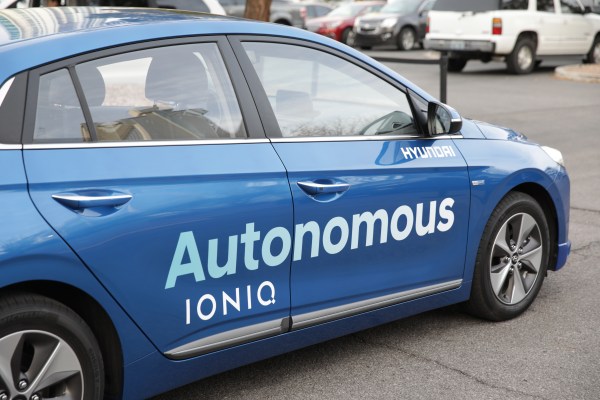Hyundai’s driverless Ioniq pulls up smoothly up to pick up me and TC’s Rebecca Friedman – though a driver is actually in the cockpit at this point, controlling the vehicle, so its performance is hardly noteworthy. But on the outside, the Hyundai Ioniq hybrid vehicle is equally lacking in distinguishing traits – beyond the body wrap emblazoned with Ioniq autonomous branding, it looks like a regular production car.
As we settle into the back seat, it’s apparent something is different. The vehicle has two rear-mounted displays that mirror a third in the center console between the driver’s seat and the front passenger. All three of these screens (iPads, if you’re curious) show vehicle passengers a simplified information display representing the car, its basic surroundings, current speed – and a steering wheel icon that lets you know, somewhat ironically, when there’s no need for a human to be using said wheel.
The drive began with the human safety driver taking us out onto Las Vegas’ Paradise Road, but once we’d merged into traffic he turned on the autonomous system and took his hands off the wheel. The course was a short, roughly 1 mile loop, and we could track our progress on the display. Unlike in a lot of demo autonomous cars, this display, with its polished graphical representation of the car and its progress, seemed almost production-ready for a real consumer.
And the autonomous system also performed in a way that almost felt ready for regular drivers and real roads – almost. The system remained engaged throughout the first half of the drive, handling turns and stops with relative ease. But the car began rolling backwards ever so slowly while we were stopped on an incline in traffic, leading to the only slightly tense moment of the drive, as we did get close to the car behind. The safety driver had to take over manual control to get us past the light, but once he resumed the autonomous driving mode, it proceeded uneventfully for the remainder of the trip.
Hyundai’s approach to autonomy focuses on leveraging things like detailed maps, to supplement a lighter sensor load out and reduce costs both for producer and consumer. It likely is playing with a very detailed and well-trod picture of the route it’s running for demos at CES this year, the one we experienced, but it was still impressive barring the one time the driver needed to take over.
[gallery ids="1433715,1433722,1433721,1433720,1433719,1433718,1433717,1433716,1433714"]
And we’re still in early days for Hyundai’s autonomous tech – the company is hoping to get everything in its sensor package ready to roll by 2021, but production might not begin until sometime after that pending regulatory progress and customer appetite for driverless tech.
